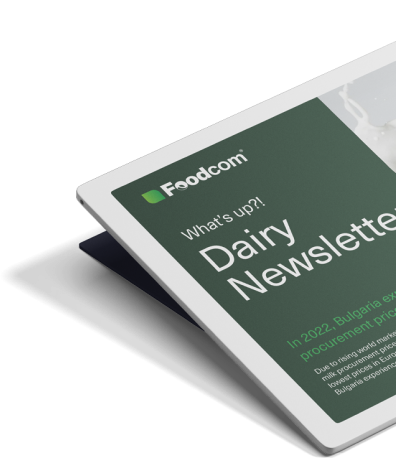- Milk powders – the market is under pressure from oversupply and weak exports, with limited prospects for improvement in the near future.
- Cheese – mozzarella remains stable, but other types are struggling with surpluses and falling prices.
- Fats and liquids – butter and cream are becoming cheaper, and supply surpluses are weakening the market; only some segments remain stable.
- Global events – France battled cattle disease, Australia saw major market consolidation, and China extended its anti-subsidy investigation into the EU.
Welcome Partners!
Welcome back to our newsletter!
After a month-long break, we are back with a new batch of information from the dairy market!
August, usually a quiet period, brought significant price drops and growing supply pressure. Butter and milk powders in Europe became cheaper almost week by week, and buyers returning from vacation found a market full of offers and stocks. Whey and milk proteins continued to maintain high price levels, although the first signs of weakness appeared there as well.
On a global scale, the United States stood out with its strong export momentum, as did New Zealand, which was preparing for a new dairy season – potentially a key factor for market balance this fall.
Scroll down for detailed market data and forecasts.
Milk powder
August proved to be a difficult month for the European milk powder market. Skimmed milk powder (SMP) production in the first half of the year increased by over 7% y/y, and weak exports were unable to absorb the surpluses. As a result, prices remained in the range of EUR 2300-2350/MT, and additional stocks exacerbated the downward pressure. Buyers, still operating in a holiday rhythm, were unable to offset it.
The SMP feed market remained more stable. In August, prices rose from around EUR 2300 to 2350–2400 EUR/MT. Demand from importers in North Africa and the Middle East partially supported prices, although volumes remained limited. Compared to the food segment, SMP feed performed better and remained relatively stable despite increasing production.
In the full cream milk powder (FCMP) market, prices remained stable in August in the range of 4050-4150 EUR/MT, despite limited demand from the chocolate and confectionery industries. Producers focused on current sales, avoiding the risk of excessive stockpiling.
Outlook: No breakthrough is expected in the coming months. SMP in Europe will continue to struggle with oversupply and weak exports, while SMP prices may come under pressure from rising production in New Zealand. The key will be whether export contracts can improve the balance between supply and demand, otherwise autumn will remain a difficult period for the milk powder market.
Cheese
August brought clear differences in the cheese market. Mozzarella maintained prices around 4000 EUR/MT thanks to stable demand in the catering sector. The situation was different for Gouda and Edam, which fell to around 3850-3950 EUR/MT under pressure from high stocks. In the UK and Ireland, producers actively directed additional volumes to the market in an effort to avoid a build-up of stocks ahead of the fourth quarter.
The Cheddar cheese market saw declines. Mild Cheddar dropped to 4300-4350 EUR/MT, while Mature Cheddar also faced downward pressure, though long-term contracts helped it to maintain relatively higher price levels.
Data for the first half of the year confirmed an increase in cheese production in both Europe and the US. Greater availability of whey and milk proteins is a factor that may put additional pressure on cheese prices in the coming months.
Outlook: The pace of demand recovery in Northern Europe after the summer period will be crucial in the fall. Mozzarella should maintain a stronger position, while surpluses of Gouda and Edam will continue to weigh on the market, increasing the risk of further price declines.
Fats
At the end of the summer, the European butter market weakened significantly. Growing production, higher imports, and a decline in exports exacerbated the supply surplus. Already in the first four months of the year, the EU milk fat balance exceeded the 2024 result by 26 000 tons and the 2023 result by 6500 tons. This resulted in growing stocks, which began to weigh more heavily on the market in August. Butter prices fell to 6300-6400 EUR/MT. This marked the steepest decline in butter prices in a long time, falling by 300-400 EUR/MT.
An additional sign of the deteriorating situation was the price of cream. Not long ago, it reached nearly 8900 EUR/MT, only to fall below 8000 EUR/MT at the end of the summer. The AMF market, on the other hand, remained relatively stable, supported by regular industrial and export demand.
The situation was different in other markets. In Oceania, butter prices remained stable at around 6200 EUR/MT, while in the United States they dropped even lower to about 4600 EUR/MT.
Outlook: In the coming weeks, the European butter market will remain under pressure from surpluses and weaker exports. Additional supplies from Oceania reduce the chances of a price rebound. The AMF segment should remain stable thanks to steady industrial demand, while further declines are more likely than increases in butter prices.
Liquids
In August, cream prices fell significantly after reaching record highs earlier in the year. From nearly 8900 EUR/MT at the beginning of the summer, they fell below 8000 EUR/MT. Cooler weather in Europe increased milk supply and cream availability, which translated into lower prices. In addition, buyers approached the market with greater caution, limiting their trading activity.
In the case of SMC, prices rose slightly, especially for German products with a higher protein content (~2200 EUR/MT). French offers were slightly lower but less available. Growing demand for protein and limited supply of raw materials sustained the upward trend.
Outlook: In the coming period, cream prices will largely depend on the weather and milk supply. With stable conditions, it is difficult to expect a return to previous records. SMC should maintain a stronger position thanks to demand for protein, and limited availability of raw material may lead to further price increases.
Whey powder
Last month, the whey powder (SWP) market was characterised by low dynamics. Prices for the food category remained in the range of 1000-1050 EUR/MT, and for feed increased to 900–950 EUR/MT. Limited demand from Asian customers reduced export activity, and producers focused more on products with a higher protein content (WPC 80, WPI), which reduced the supply of available feed whey.
Whey protein concentrates remained at high price levels. WPC 80 was priced at an average of 12 000 EUR/MT in Europe and around EUR 9500 EUR/MT in the US. Most of the Q3 volumes were already contracted, and offers for Q4 were appearing at higher prices, indicating continued competition for limited available quantities.
The whey protein isolate market gained strength, with WPI trading at 19 600-19800 EUR/MT in Europe and around 18 500 EUR/MT in the US. Strong demand and expectations of lower availability later in the year sustained the price trend.
Whey permeate remained the weakest link in the whey market. European offers hovered around 800 EUR/MT, while American offers were significantly lower, in the range of 480-500 EUR/MT. Lack of demand in Asia meant that the market remained sluggish.
The lactose market in Europe weakened in August, with spot offers being revised downwards. In the US, prices were supported by exports, especially to South and Central America and Southeast Asia, although Chinese purchases remained significantly limited.
Outlook: At the beginning of autumn, the whey powder market will remain affected by limited demand from Asian customers. WPC 80 and WPI should maintain high price levels thanks to global demand for protein. Permeate and lactose will remain affected by limited demand, staying at relatively low price levels.
What happened in August?
France
At the end of August, the so-called Lumpy skin disease (lumpy skin disease), which had been threatening dairy cow farms for several months, was brought under control in France. The disease is not dangerous to humans, but it reduces milk yields and hits farmers hard. Since May 2025, cases of the disease have appeared in areas bordering Switzerland and Italy, resulting in export restrictions for French cheeses made from raw milk (e.g. reblochon, tomme, Beaufort), among others. In August, more than 220,000 cows were vaccinated and 1,700 individuals were sedated. This has virtually stopped the spread of the disease. For the French dairy sector, this is of great importance, as cheese exports are one of the pillars of revenue – without this stabilisation, the market would lose further trade contracts.
Australia
In August, French conglomerate Lactalis finalised the purchase of the Australian assets of New Zealand’s Fonterra for around $4.2 billion. This is the largest deal in the history of the Australian dairy sector. Combined with the operations of Canada’s Saputo, it means the two companies now control more than 40% of Australia’s milk production. Australian farmers are concerned that such a strong position for foreign concerns will reduce their bargaining power and put pressure on farmgate prices. Some analysts even argue that this is the end of the ‘Australian model’ based on cooperatives and local processing. Fonterra, on the other hand, is withdrawing from the retail market and betting on B2B activities: milk powder, whey, dairy ingredients for the food industry. This shows a global trend – major companies want to specialise and control entire supply chains, rather than have fragmented retail operations. For consumers in Australia, the changes could mean more product standardisation, but also fewer local brands on the shelves
China
In mid-August, China’s Ministry of Commerce announced the extension of an anti-subsidy investigation into dairy products from the European Union until February 2026. The investigation covers cheese, milk and cream, among others. Beijing argues that European producers receive too much public support, which distorts competition in the international market. In practice, however, many experts believe that this is part of a wider trade war that will affect the US in addition to the EU. For EU producers, the issue is serious because China is one of the largest dairy importers in the world. Potential tariffs or other restrictions could significantly reduce the profitability of exports and force companies to look for new markets. For the time being, European industry organisations are calling for dialogue and insisting that agricultural subsidies in the EU are within international rules. However, the prolongation of the investigation means that uncertainty will continue for many more months.
![Autumn knocks earlier on the dairy market [279 Edition of DAIRY Newsletter] Autumn knocks earlier on the dairy market [279 Edition of DAIRY Newsletter]](https://foodcom.pl/wp-content/uploads/2024/06/Foodcom_SA_Dairy_Newsletter_3-1520x760.jpg)


![Summer dispersal and inventory pressure – the dairy market is waiting for a boost [278th Edition of DAIRY Newsletter] Summer dispersal and inventory pressure – the dairy market is waiting for a boost [278th Edition of DAIRY Newsletter]](https://foodcom.pl/wp-content/uploads/2023/08/Foodcom_SA_Whats_up_Newsletter_Dairy-600x300.jpg)
![Oversupply and faltering exports – dairy markets in the shadow of the summer slowdown [277th Edition of DAIRY Bulletin] Oversupply and faltering exports – dairy markets in the shadow of the summer slowdown [277th Edition of DAIRY Bulletin]](https://foodcom.pl/wp-content/uploads/2023/08/Foodcom_Newsletter_Dairy-600x300.jpg)
![Falling prices with rising costs – dairy in the midst of a seasonal solstice [276th Edition of DAIRY Bulletin] Falling prices with rising costs – dairy in the midst of a seasonal solstice [276th Edition of DAIRY Bulletin]](https://foodcom.pl/wp-content/uploads/2023/08/Foodcom_SA_Newsletter_Dairy-600x300.jpg)

